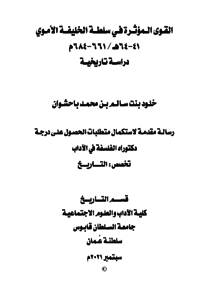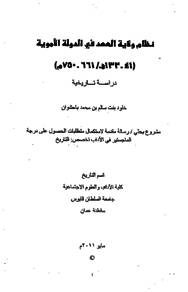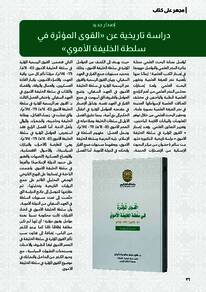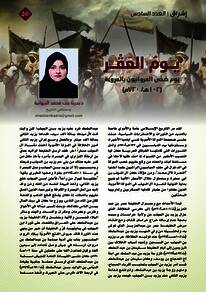Document
القوى المؤثرة في سلطة الخليفة الأموي، 41-64هـ/ 661-684م.
Other titles
The Influencing Forces on the Reign of Umayyad Caliph (41-64 A.H/ 661- 684 C.E)
Publisher
جامعة السلطان قابوس.
Gregorian
2021
Language
Arabic
English abstract
The study aimed at discovering the influencing factors in the rule
of Umayyad Caliph. It identifies the levels of decision-making during
Sufyani era, states the official and unofficial forces that affected the rule
of Umayyad Caliph during Sufyani era, and traces the factors and
circumstances that contributed to making decisions during Sufyani era.
The study includes an introduction, a preface, four chapters, and a
conclusion, in addition to a list of primary sources and recent references
used in this research. The preface includes: the influencing factors in
governance transfer to Umayyads. Chapter one deals with the power and
authority of caliph in Umayyad era (41-64 A.H/ 661-684 C.E), the
concept of power in Islam, the legitimacy and power of Umayyad Caliph,
and the levels of decision-making in the Umayyad state. Chapter two
talks about: the official forces influencing the reign of Umayyad Caliph
(41-64 A.H/ 661-684 C.E) including: mandate of covenant, Umayyad
princes, senior military leaders, workers, governors, judges, and writers
during Sufyani era. Chapter three presents the informal forces affecting
the reign of Umayyad Caliph (41-64 A.H./ 661-684 C.E.) including
tribes' leaders, lineage of caliph, entourage, poets, and loyalists. Chapter
four examines the factors affecting the reign of Umayyad Caliph (41-64
A.H./ 661-684 C.E.) including opposition (political parties and currents),
economic situation, conditions of military fronts, and outposts on the
borders of the state .
In her study, the researcher adopted the historical descriptive
analytical method that is based on collecting, analyzing, and then
comparing historical narratives to reach the study's results.
The study concluded that there are multiple levels of authority
during the Sufyani era in Umayyad state. Moreover, the power of
Umayyad Caliph in making decisions is relatively governed by a number
of influencing factors and forces which were not absolute as it seems to
people. There is disparity in the forces influencing the reign of caliph
during the Umayyad era according to the circumstances and events taking
place including political developments. The results of the study reveal
that there is much overlap and intertwine in the topic of the influencing
forces on the Reign of Umayyad Caliph (41-64 A.H./ 661-684 C.E)
Member of
Resource URL
Arabic abstract
هدفت هذه الدراسة إلى الكشف عن العوامل المؤثرة في سلطة الخليفة الأموي، وذلك بتحديد مستويات صنع القرار في العهد السفياني، وبيان القوى الرسمية والقوى غير الرسمية المؤثرة في سلطة الخليفة الأموي في العهد السفياني، وتتبع العوامل والظروف التي أسهمت في صنع القرار في العهد السفياني. وقُسمت الدراسة إلى: مقدمة، وتمهيد، وأربعة فصول، وخاتمة، بالإضافة إلى قائمة المصادر الأولية والمراجع الحديثة التي اعتمدت عليها الدراسة. وتناول التمهيد العوامل المؤثرة في انتقال الحكم إلى بني أمية، بينما تطرق الفصل الأول إلى سلطات الخليفة وصلاحياته في العصر الأموي ( 41- 64هـ/ 661- 684م)، وقد اشتمل الفصل على: مفهوم السلطة في الإسلام، يليه الشرعية وسلطة الخليفة الأموي، ويعقبهما مستويات صنع القرار واتخاذه في الدولة الأموية، أما الفصل الثاني فتضمن: القوى الرسمية المؤثرة في سلطة الخليفة الأموي ( 41- 64هـ/ 661- 684م)، مبيِّنًا تأثير كل من: ولاية العهد، والأمراء الأمويين، وكبار القادة العسكريين، والعمال والولاة، والقضاة والكتّاب في سلطة الخليفة الأموي في العهد السفياني. واختصَّ الفصل الثالث بـ: القوى غير الرسمية المؤثرة في سلطة الخليفة الأموي (41- 64هـ/ 661- 684م)، والتي تمثلت في: زعماء القبائل، وبطانة الخليفة وحاشيته، والشعراء، والموالي. أما الفصل الرابع فقد استعرض: العوامل المؤثرة في سلطة الخليفة الأموي (41- 64هـ/ 661- 684م)، وهي: المعارضة (الأحزاب والتيارات السياسية)، والأحوال الاقتصادية، وكذلك أوضاع الجبهات العسكرية والثغور على حدود الدولة الإسلامية وتأثيرها في سلطة الخليفة الأموي في الفترة موضوع الدراسة.
اعتمدت الباحثة في دراستها على منهجين متداخلين، وهما: المنهج التاريخي القائم على قراءة النصوص وتحليلها، والمنهج الاستنباطي الذي يفضي إلى إصدار الأحكام والتأسيس.
خَلُصت الدراسة إلى عدد من النتائج كان أبرزها: تعدد مستويات السلطة في العهد السفياني من الدولة الأموية، وأن سلطة الخليفة الأموي في اتخاذ القرارات كانت محكومة نسبياً بعدة عوامل وقوى مؤثرة؛ أي أنها لم تكن مطلقة إطلاقًا تامًّا كما يبدو للكثير من الناس، إضافةً إلى تفاوت نسبِ تأثير القوى المؤثرة في سلطة الخليفة في العصر الأموي تِبْعًا للظروف والأحداث ومستجدات التطورات السياسية، مع وجود الكثير من التداخل والتشابك في موضوع القوى المؤثرة في سلطة الخليفة الأموي في الفترة الزمنية موضوع البحث
اعتمدت الباحثة في دراستها على منهجين متداخلين، وهما: المنهج التاريخي القائم على قراءة النصوص وتحليلها، والمنهج الاستنباطي الذي يفضي إلى إصدار الأحكام والتأسيس.
خَلُصت الدراسة إلى عدد من النتائج كان أبرزها: تعدد مستويات السلطة في العهد السفياني من الدولة الأموية، وأن سلطة الخليفة الأموي في اتخاذ القرارات كانت محكومة نسبياً بعدة عوامل وقوى مؤثرة؛ أي أنها لم تكن مطلقة إطلاقًا تامًّا كما يبدو للكثير من الناس، إضافةً إلى تفاوت نسبِ تأثير القوى المؤثرة في سلطة الخليفة في العصر الأموي تِبْعًا للظروف والأحداث ومستجدات التطورات السياسية، مع وجود الكثير من التداخل والتشابك في موضوع القوى المؤثرة في سلطة الخليفة الأموي في الفترة الزمنية موضوع البحث
Category
Theses and Dissertations




